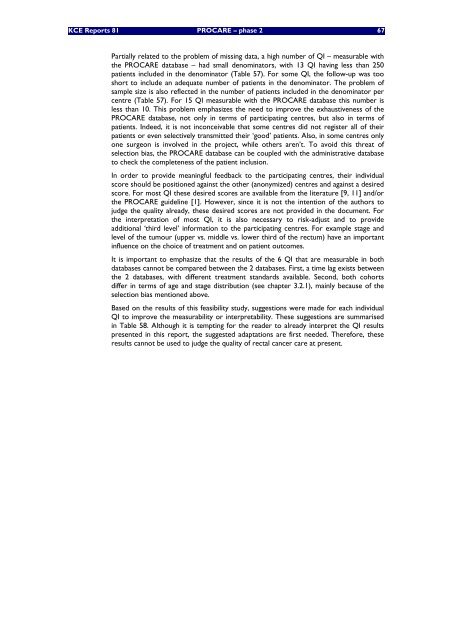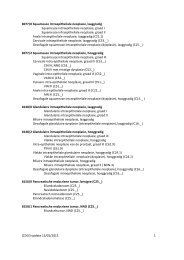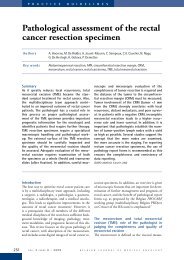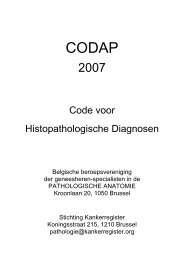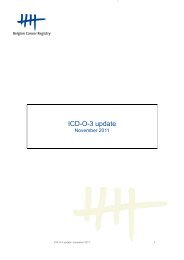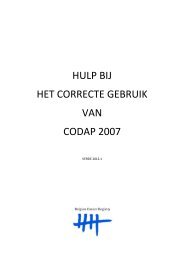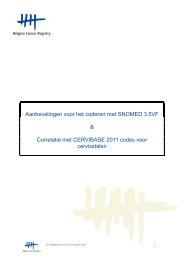66 PROCARE <strong>–</strong> <strong>phase</strong> 2 KCE reports 813.3 DISCUSSION3.3.1 Measurability of the se<strong>le</strong>cted quality indicatorsA major objective of the present study was to analyse the feasibility of measuring QI for<strong>rectal</strong> <strong>cancer</strong> care using a prospective database and an administrative database. Of the40 final QI, 30 were measurab<strong>le</strong> for the prospective cohort and 9 were measurab<strong>le</strong> forthe administrative cohort. For the overall 5-year survival (and relative 5-year survival)the follow-up in the prospective cohort was too short to be measurab<strong>le</strong> yet. This QI(and the relative 5-year survival) was measurab<strong>le</strong> for the administrative cohort. Of the 8QI that were not measurab<strong>le</strong> for the prospective cohort, 2 were measurab<strong>le</strong> for theadministrative cohort (discussion in MDT and proportion of patients with stoma 1 yearafter sphincter-sparing surgery). Six QI were measurab<strong>le</strong> for both cohorts, whi<strong>le</strong> 7other QI were not measurab<strong>le</strong> for both cohorts (including the disease-specific 5-yearsurvival).In the prospective database, the main reason for not being measurab<strong>le</strong> was the absenceof a co<strong>de</strong> (n = 5) or a specific co<strong>de</strong> (n = 2). One QI was not measurab<strong>le</strong> because ofinconsistencies in the database. In theory, these prob<strong>le</strong>ms can be solved by addingvariab<strong>le</strong>s to or adjusting existing variab<strong>le</strong>s in the PROCARE registration form. However,adding variab<strong>le</strong>s would increase the bur<strong>de</strong>n of registration for the involved healthcareprovi<strong>de</strong>rs. I<strong>de</strong>ally and where possib<strong>le</strong>, the PROCARE database should be linked to theadministrative databases for those QI that are not measurab<strong>le</strong> using the PROCAREdatabase alone. In theory, this is possib<strong>le</strong> through the unique patient i<strong>de</strong>ntifier.In the administrative database, the absence of co<strong>de</strong>s for clinical outcomes (mainly R0resection) and results (e.g. cCRM) was the main reason for not being measurab<strong>le</strong> (n =21). For 7 other QI, the availab<strong>le</strong> administrative co<strong>de</strong>s were too unspecific. Incomparison to the prospective database, it is much more difficult (and probablyimpossib<strong>le</strong>) to add co<strong>de</strong>s. The used administrative databases, in particular the HIC andTC databases, were build for financing reasons rather than for measuring the quality ofcare.3.3.2 Definition of quality indicatorsSome of the se<strong>le</strong>cted QI are <strong>de</strong>fined for specific subpopulations, such as patientsun<strong>de</strong>rgoing surgery or treatment in general. Of course, many of these QI are alsoapplicab<strong>le</strong> to a broa<strong>de</strong>r group of patients with <strong>rectal</strong> <strong>cancer</strong>. For examp<strong>le</strong>, stagingprocedures (such as pelvic CT, large bowel-imaging, etc.) are necessary to <strong>de</strong>ci<strong>de</strong> onfurther treatment for all patients, and not only for patients eventually un<strong>de</strong>rgoingtreatment [1]. Neverthe<strong>le</strong>ss, the message of this study should be that most QI aremeasurab<strong>le</strong> or can be ren<strong>de</strong>red measurab<strong>le</strong>. In a later <strong>phase</strong>, it can be <strong>de</strong>ci<strong>de</strong>d toenlarge the scope of each individual QI. Additional risk-adjustment will then benecessary for some QI.3.3.3 Possib<strong>le</strong> prob<strong>le</strong>ms with the interpretation of the quality indicatorsA high number of missing data was i<strong>de</strong>ntified. For 18 of the 30 QI measurab<strong>le</strong> with theprospective database, the % missing data excee<strong>de</strong>d 10% (Tab<strong>le</strong> 57). Most frequently,missing data were caused by an unknown cStage or (y)pStage or an unknownchemotherapy or radiotherapy regimen. The % missing data was lower for theadministrative database, with more than 10% missing data for 2 of the 10 measurab<strong>le</strong>QI. The sing<strong>le</strong> most important cause was an unknown cStage.For 6 QI it was impossib<strong>le</strong> to calculate the exact % of missing data in the prospectivedatabase because of the presence of variab<strong>le</strong>s with a <strong>de</strong>fault value ‘0’. To increase thereliability of the PROCARE database, all variab<strong>le</strong>s with <strong>de</strong>fault value ‘0’ should bei<strong>de</strong>ntified and adapted to allow an i<strong>de</strong>ntification of missing data.
KCE Reports 81 PROCARE <strong>–</strong> <strong>phase</strong> 2 67Partially related to the prob<strong>le</strong>m of missing data, a high number of QI <strong>–</strong> measurab<strong>le</strong> withthe PROCARE database <strong>–</strong> had small <strong>de</strong>nominators, with 13 QI having <strong>le</strong>ss than 250patients inclu<strong>de</strong>d in the <strong>de</strong>nominator (Tab<strong>le</strong> 57). For some QI, the follow-up was tooshort to inclu<strong>de</strong> an a<strong>de</strong>quate number of patients in the <strong>de</strong>nominator. The prob<strong>le</strong>m ofsamp<strong>le</strong> size is also ref<strong>le</strong>cted in the number of patients inclu<strong>de</strong>d in the <strong>de</strong>nominator percentre (Tab<strong>le</strong> 57). For 15 QI measurab<strong>le</strong> with the PROCARE database this number is<strong>le</strong>ss than 10. This prob<strong>le</strong>m emphasizes the need to improve the exhaustiveness of thePROCARE database, not only in terms of participating centres, but also in terms ofpatients. In<strong>de</strong>ed, it is not inconceivab<strong>le</strong> that some centres did not register all of theirpatients or even se<strong>le</strong>ctively transmitted their ‘good’ patients. Also, in some centres onlyone surgeon is involved in the project, whi<strong>le</strong> others aren’t. To avoid this threat ofse<strong>le</strong>ction bias, the PROCARE database can be coup<strong>le</strong>d with the administrative databaseto check the comp<strong>le</strong>teness of the patient inclusion.In or<strong>de</strong>r to provi<strong>de</strong> meaningful feedback to the participating centres, their individualscore should be positioned against the other (anonymized) centres and against a <strong>de</strong>siredscore. For most QI these <strong>de</strong>sired scores are availab<strong>le</strong> from the literature [9, 11] and/orthe PROCARE gui<strong>de</strong>line [1]. However, since it is not the intention of the authors tojudge the quality already, these <strong>de</strong>sired scores are not provi<strong>de</strong>d in the document. Forthe interpretation of most QI, it is also necessary to risk-adjust and to provi<strong>de</strong>additional ‘third <strong>le</strong>vel’ information to the participating centres. For examp<strong>le</strong> stage and<strong>le</strong>vel of the tumour (upper vs. midd<strong>le</strong> vs. lower third of the rectum) have an importantinfluence on the choice of treatment and on patient outcomes.It is important to emphasize that the results of the 6 QI that are measurab<strong>le</strong> in bothdatabases cannot be compared between the 2 databases. First, a time lag exists betweenthe 2 databases, with different treatment standards availab<strong>le</strong>. Second, both cohortsdiffer in terms of age and stage distribution (see chapter 3.2.1), mainly because of these<strong>le</strong>ction bias mentioned above.Based on the results of this feasibility study, suggestions were ma<strong>de</strong> for each individualQI to improve the measurability or interpretability. These suggestions are summarisedin Tab<strong>le</strong> 58. Although it is tempting for the rea<strong>de</strong>r to already interpret the QI resultspresented in this report, the suggested adaptations are first nee<strong>de</strong>d. Therefore, theseresults cannot be used to judge the quality of <strong>rectal</strong> <strong>cancer</strong> care at present.


